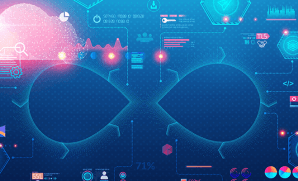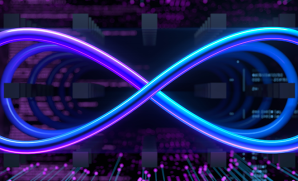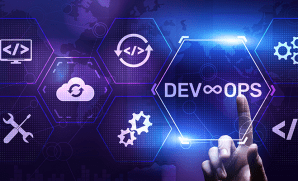Imagine a world where content creation flows at your command, and software builds itself with a little AI nudge. Generative AI, the rising star of artificial intelligence, is making this a reality. Fueled by breakthroughs like OpenAI’s ChatGPT, DALL-E2, and more, it’s already transforming how we generate content, with market projections expecting a staggering growth from $11.3 billion in 2023 to $76.8 billion by 2030. However, its influence extends beyond developing whitepapers and videos. Generative AI aims to revolutionize DevOps, the backbone of modern software development.
The DevOps landscape is experiencing a seismic transformation, with generative AI tools like GitHub Copilot leading the charge. This AI “pair programmer” acts as your real-time coding sidekick, suggesting solutions and automating repetitive tasks across the entire tech stack.
The global generative AI in DevOps market is poised for explosive growth, surging from $942.5 million in 2022 to $22.1 billion by 2032. This isn’t just about automation; it’s about completely reshaping technical workflows. Generative AI empowers DevOps teams to become superheroes of efficiency.
Imagine faster, more precise decision-making fueled by AI-powered automation and analysis of massive datasets. Generative AI empowers DevOps teams to enhance decision-making speed and precision by automating core processes and analyzing extensive data sets.

Image Source: Global Generative AI in DevOps Market
Why and How DevOps Needs to Change
DevOps combines practices and tools that improve an organization’s ability to deliver applications and solutions quickly. It enriches products more speedily than traditional software development and infrastructure management processes.
Despite its increasing adoption, DevOps relies on multiple tools, including repetitive manual tasks that, while necessary, don’t directly contribute to the final product’s business value. Enter generative AI – a technology capable of handling these tasks, reducing development cycles, accelerating time-to-market, and enhancing customer satisfaction.
Beyond automatic code generation, automated testing, and deployment automation, generative AI ventures into infrastructure management through Infrastructure as Code (IaC). AI can also help build models to monitor system performance and identify real-time anomalies.
Currently, the use of AI systems in DevOps is limited, focusing on content generation. DevOps assistants can deliver excellent value by providing intent and action-based experiences to activate workflow steps and apply state changes. For example, merging Copilot’s code authorship with a conversational interface empowers DevOps engineers to initiate on-demand processes and provide necessary inputs. Importantly, these capabilities don’t replace humans or alter their roles drastically. Instead, generative AI improves engineering abilities, handles routine tasks, and ensures safety mechanisms. This leverage enables DevOps teams to focus on more meaningful work, achieving greater efficiency in less time.
Areas where Generative AI optimizes DevOps
With its vast potential for improving DevOps, generative AI is set to dominate in three major domains:
Automated failure detection followed by remedy recommendations: This addresses the challenge of frequent failures in software development. In the dynamic application development landscape, sudden interruptions can disrupt productivity, impact release schedules, and cause frustration when remediation efforts fall short. Generative AI agents prove invaluable in swiftly identifying errors and their underlying causes. Leveraging knowledge from past failures, these agents recommend immediate actions within the context of the displayed alert. By critically examining code, test outcomes, and relevant data, generative AI becomes a proactive tool in preemptively addressing potential issues and their root causes, empowering developers to rectify bugs before they escalate into significant problems.
On-demand Code/Config Generation and Deployment: Generative AI’s on-demand Code/Config Generation and Deployment feature adds substantial value with its code authoring capability and user-friendly conversational interface. Developers can efficiently initiate tasks by crafting a brief message in a chat interface, instructing the AI agent to set up projects, config files, or Terraform states. The agent may prompt for necessary template values and notify stakeholders for review upon completion. Upon approval, the AI informs the developer and launches the project into the live environment. This streamlined process consolidates multiple workflows into a single self-service action, allowing DevOps teams to redirect their focus from manual resource provisioning to more critical tasks.
Prompt-driven workflow management: Next-gen AI agents go beyond simple text and image creation to support automated prompt-driven workflows. For example, bidirectional AI facilitates process initiation using natural language, like instructing it to “deploy the application on containers,” seamlessly interacting with AWS Elastic Kubernetes Service (EKS). Developers are relieved from specifying platforms or steps; the AI interprets words through domain knowledge, understanding, for instance, that the “production” cluster resides on AWS. As the agent executes workflows, it refines its capabilities, suggesting similar processes for future scenarios. This generative AI intermediary ensures consistent and secure workflow initiation, prompting relevant inputs and allowing anyone to navigate workflows effortlessly, such as selecting cloud accounts or specifying machine types during tasks like “add a new virtual machine.”
Accelerating DevOps Work with Generative AI
The landscape of DevOps is undergoing a significant transformation fueled by the emergence of generative AI. This technology holds immense potential to streamline core tasks, enhance workflow accessibility, and drive consistent progress in developing new functionalities. However, carefully considering both the benefits and potential challenges is essential for seamless integration. While AI agents bolster automated security, preemptive measures are essential to prevent potential threats from exploiting system vulnerabilities.
While generative AI presents significant benefits, its current limitations demand careful consideration. One key challenge lies in the limited transparency of some models’ decision-making processes. This opacity can hinder DevOps engineers’ ability to validate the reasoning behind AI recommendations, potentially leading to trust issues and reduced adoption.
Furthermore, seamless integration of AI into existing DevOps workflows requires a substantial investment of time, resources, and personnel with the necessary skills. Not all organizations are equipped to handle this paradigm shift, and successful adoption may necessitate a measured approach focusing on building internal capabilities.
In conclusion, generative AI presents a powerful toolkit for optimizing DevOps workflows. The evolving generative AI landscape promises resolution as AI algorithms fine-tune, reiterate, and re-calibrate their deep learning abilities. The most successful deployments of generative AI will prioritize addressing genuine business needs, focusing on metrics that directly impact development processes. Examples include accelerating incident resolution or increasing issue closure rates. By aligning AI with these clear objectives, DevOps teams can unlock the true potential of this technology.










